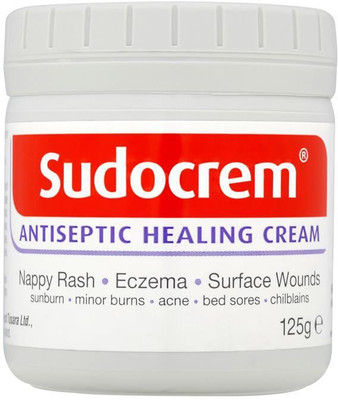SUDOCREM Antiseptic Healing Cream - 125g (Pack of 2)(250 g)
Quick Overview
Product Price Comparison
Details Sudocrem Antiseptic Healing Cream has been mumŌĆÖs simple, effective ally for over 85 years and is great for soothing sore skin and treating nappy rash and has been proven to reduce nappy rash rapidly.* Sudocrem Antiseptic Healing Cream is versatile enough to be used by the whole family for all of lifeŌĆÖs little dramas and can help with so much more than just treating babiesŌĆÖ bottoms! Treating nappy rash Sudocrem is clinically proven to soothe and heal your babyŌĆÖs delicate skin and works in three simple ways: an emollient soothes sore or inflamed skin; its ingredients are recognised for their healing properties; and a mild local anaesthetic helps to ease pain and irritation. Cuts, grazes and minor burns Sudocrem provides gentle yet effective relief from cuts, grazes and minor burns. It helps to heal wounds by forming a protective layer over the vulnerable area. In other words, itŌĆÖs a very useful little tub to keep around the house! How to use? Nappy rash Apply Sudocrem Antiseptic Healing Cream to help treat and heal existing nappy rash and soothe your babyŌĆÖs skin. Step 1: Ensure your babyŌĆÖs bottom is clean and dry Step 2: With clean and dry hands, place a small amount of Sudocrem on the tip of your finger. Remember, a little goes a long way Step 3: Gently massage the cream into the skin using light, circular movements. Try to avoid rubbing, especially if the skin looks sore Step 4: Try to create a thin, translucent film on the skin. If white cream is still visible then you may have used too much (donŌĆÖt worry, your baby will be fine, just remember to use a little less next time) Repeat these steps until the rash has cleared. Then apply Sudocrem Care & Protect at every change to help prevent nappy rash. Other uses ŌĆō from minor sunburn to cuts and grazes Step 1: Ensuring your hands are clean and dry, place a small amount of Sudocrem Antiseptic Healing Cream on the tip of your finger Step 2: Gently massage the cream into the affected area using light, circular movements Step 3: Try to create a thin, translucent film on the skin. If the white cream is still visible then you may have used too much (this is ok, just remember to use a little less next time)


